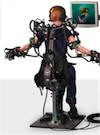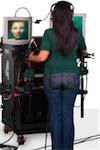Working to improve my own abilities as a Hands-On Producer, I sneak away from the office when I can to explore new technologies that may make me more valuable to the people we work with.
So when friend and colleague David Conley (a VFX producer on projects like Terminator: Salvation and Cloverfield) invited me to a tour of Jim Henson’s new Digital Puppetry Studio, I leapt at the chance for a total Geek-Out Session.
How the Henson Digital Puppetry Studio Works
In a nutshell: at Jim Henson’s Digital Puppetry Studio, puppeteers bring 3d characters alive in a virtual world, and cameramen film the scenes in real-time, much as they would on a regular TV set. Seriously!
This process allows for a whole new level of creativity and spontaneity in computer generated productions. In fact, the studio recently won a technical Emmy for their achievements in this area.
Puppets for the 21st Century
Steffen Wild, director of the Digital Puppetry Studio, walked us through the amazing setup used on a wide-range of projects like Sid the Science Kid, Farscape, and even 30 Rock.
Rigs, like the one seen here, connect world-class puppeteers to their 3d characters. By bending fingers, flicking wrists, and even stomping on pedals, puppeteers can make 3d characters leap to life in their virtual world.
They can control everything from huge motions like running and tumbling, to to the tiniest movements like bending a finger or twitching a nose.
Even cooler, every rig is “fine tuned” for each artist, almost like a musical instrument. An artist can program the buttons, triggers, pedals, and the gestures they make to respond however he or she likes, adding infinite layers of detail and humanness to performances.
Because every moment comes alive on video monitors surrounding the puppeteers, they get real-time feedback, showing how their performances look in the computer generated world.
Steffen explained that this is an evolutionary step from the days when puppeteers, like those running Kermit T. Frog, would look at a small, black-and-white video-feed as they hid under a stage with the puppet on their arm.
Cameras in a Virtual World
Camera stations, on the other hand, allow any camera man to walk in off the street and film the performances taking place in the digital world.
Controls just like the ones we’ve all played with in college TV stations or Public Access rooms allow one to zoom, pan, tilt, and frame the action of the virtual world in real time.
Like the puppetry stations, monitors show the camera operators exactly what they are framing within the digital universe. Framing a shot is as easy as zooming in and panning over, much like playing a video game. While these stations are mounted in place, filming a digital world does not mean just standing in one spot.
For instance, insanely impressive is a virtual steadicam rig! Essentially, an operator can physically walk around a virtual set (a stepping through a big, empty sound stage) and, wearing a pair of virtual reality goggles to “see” the set, film all the digital characters and action in a scene. Steffen says they’ve filmed complete CG takes, in real-time, that are 2 minutes long!
It’s Still About the Human Touch
I was lucky enough to slip into a puppeteering rig and attempt to control Gerald from Sid the Science Kid, while David played the title role of Sid. It was unbelievably fun, but let’s just say our performances were less than stellar!
This drove home an important fact: no matter how much technology advances, at the end of the day the most whiz-bang production tools are are only as useful as the talented artists they serve.
World class puppeteers can make characters like Gerald and Sid come alive. Me and Dave, not so much!
And a real steadicam operator, using their lifetime of skills to float around an imaginary, virtual, digital world can add incredible life and subtlety to camerawork of a scene that might otherwise feel too “computer-ee.”
Take-Aways for the Hands-On Producer
While filming in a setup like this is probably out of reach for most beginning Hands-On Producers, being aware that such technology is making incredible leaps and bounds forward is valuable knowledge.
As your career takes off and your credit list grows, you may just find yourself in need of the Henson Digital Puppetry Studio. When that day comes, think of me fumbling around in a puppetry rig, and be sure to hire a pro!


